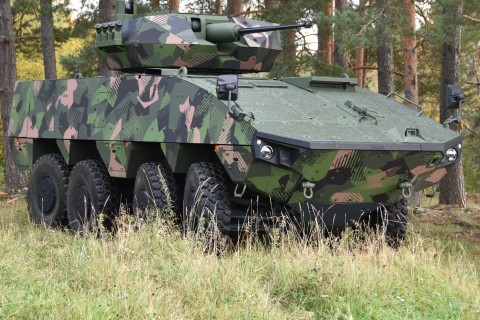
Heavy weapons refer to 81 mm and larger mortars or cannons. Their history in Finland stem from Patria's predecessor Tampella. Over the years Tampella's product range has covered grenade launchers from 47 mm to the gigantic 300 mm launcher.
A holder for carrying loads by horse (design by Friitalan nahkatehdas). Weapons departement of Tampella was established in 1932.
In the 1920's, Hans Otto Donner, a Finnish student at a French military academy, slapped Brandt's design of the 81 mm mortar on the table of Tampella's CEO and presented his improvements for the design. Donner's ideas were patented, and Tampella manufactured the first prototype for the Finnish Defence Forces in 1932. With order No. Tl 5/33 of the Ordnance Department, dated on 13 January 1933, the Defence Ministry ordered the first 100 pcs of 81 mm mortars (+ equipment) for a price of MK 32000. Although, in total 104 mortars were delivered to the Finnish Defence Forces. In connection with the delivery, the mortars received a new name, type 81 Krh/33: it is considered that the Weapons Department of Tampella originated from this procurement.
At the time the Second World War broke out, Tampella manufactured 37 mm anti-tank guns and 105 mm field howitzers. However, the main task consisted of maintaining and repairing the equipment, and until the recent years, manufacturing grenade shells and ammunition for firing session purposes for the Defence Forces. "Train loads of broken equipment and loot were brought for repair. As the Winter War ended, Field Marshal Mannerheim visited the Tampella factory to award medals and issue the order of the day," says the Head of Testing of Patria's weapon systems, Vesa Toivonen, and points out the document hanging on the wall of Patria's premises. In the 1960's, Tampella had developed the 122K60 field cannon, which was to be manufactured in the hundreds for the Finnish Defence Forces. However, at the conclusion of a trip to the Soviet Union, Urho Kekkonen decided to strike a deal to procure Soviet cannons, which resulted in Tampella losing a bulk of its production, the number of cannons being only 15. Tampella started developing a 155 mm cannon, more suitable for the international markets, and they were sold to Singapore. The Chief Designer of the cannon, Heikki Collanus, manufactured one cannon at his own cost, and when the Finnish Defence Forces needed a new cannon at the end of the 1970's, the prototype manufactured by Collanus was used as a base for the 155K83 cannons serving as heavy field cannons even today.
The story of modern turreted launchers begins from the 1990's, at which point the AMOS mortar system – combining manoeuvre and protection – was developed together with BAE Systems Hägglunds from Sweden. Its successor, the Nemo mortar system, was developed by Patria on its own.
Nemo's test firing session in 2012. Nemo is designed to be independent of the carrier.
The naval version of the Nemo system enables, for example, fire-onthe-move without compromising accuracy. The Nemo system allows firing five grenades, hitting the target from different trajectories simultaneously. The light weight – 1700 kg – is a competitive advantage allowing system installation on light-weight carriers. Patria Land Systems, in charge of developing mortar systems, arranges 10-12 firing test weeks per year. When it comes to improving the weapons range, in the 1930's, firing tests took place in the middle of Tampere, from Siilinkari to Näsijärvi. Today, firing test exercises take place in the carefully specified areas of the Finnish Defence Forces. Plenty of space is needed, as the maximum range of mortars is approximately 10 km, and over 40 km for cannons. The future challenges in weapon system production are more extensive than before: maintainability, software compatibility and product life-cycle support. This article was published in the Patria magazine in June 2013